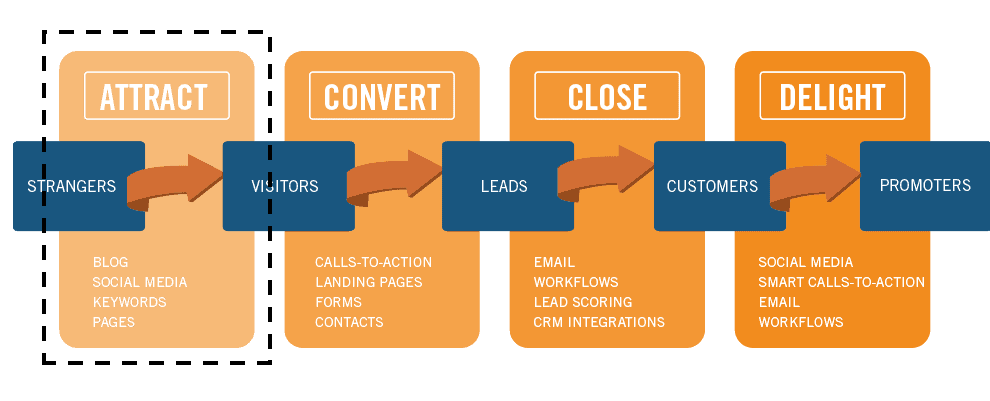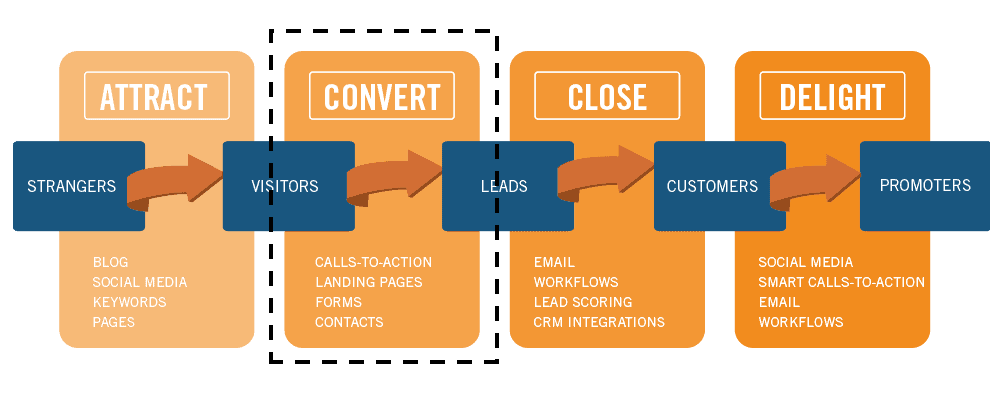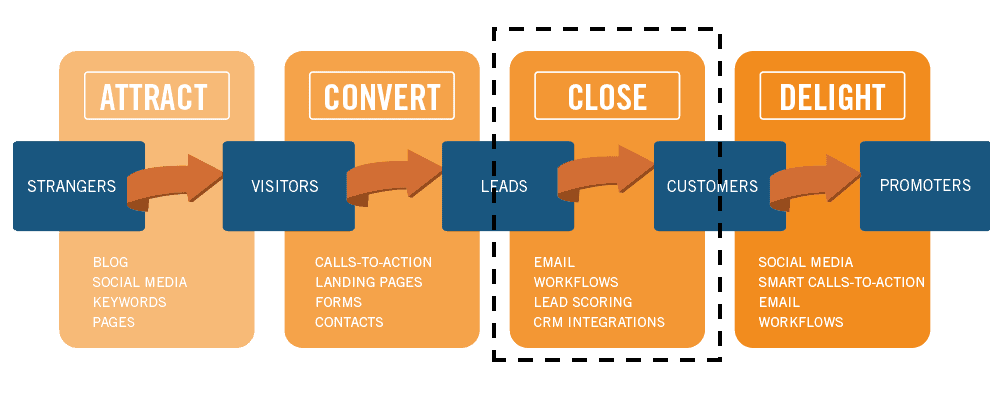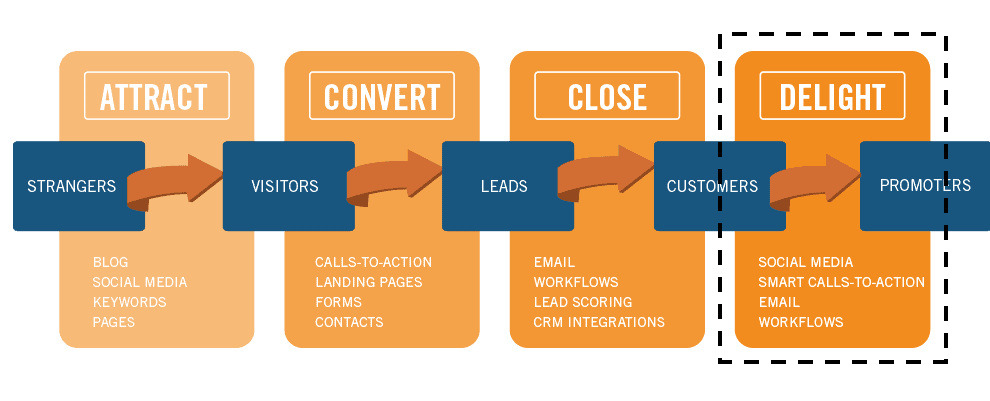In this inbound marketing guide for managers, I’m going to explain the difference between inbound marketing and outbound marketing, why inbound marketing is the preferred method for your online business, and how to start doing it successfully.
Before going further, you should know that marketing is a massive component of growing our businesses. It’s no secret that the modern digital age has given us way more opportunities to reach our audiences and determine how to approach our marketing more complicated.
Leveraging digital marketing benefits requires an overall understanding of the digital environment and a smart strategic approach.
#1. Inbound vs. Outbound Marketing
There are two significant types of marketing: inbound and outbound. All marketing tactics can be divided into these two overall categories.
Let’s address the differences between the two:
1.1 Outbound Marketing
Outbound marketing is the traditional form of marketing in which a company initiates contact by sending its message to an audience.
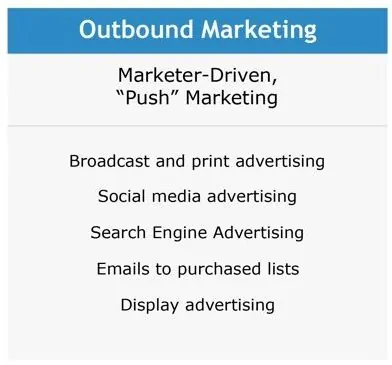
This is usually done through marketing tactics, including, but not limited to, television, radio, print, and direct mail. These tactics are often referred to as “push” tactics meaning that the marketer is pushing information to the consumer hoping that the consumer will take action.
1.2 Inbound Marketing
Inbound marketing, on the other hand, refers to marketing tactics that focus on bringing customers to your company rather than your company going to them.

By strategically developing content that is appealing to your core demographic, your goal is to attract potential customers to you. This is done through SEO, blogging, social media, and vlogging, among others.
1.3. Is Inbound marketing the best for you?
Since its inception in 2005, inbound marketing has grown to become the chief marketing technique for online business relations. It is about drawing people to your company naturally and organically.
One of the most significant advantages of inbound marketing is that it aligns with modern customer behavior.
Did you know that 57% of the sales process is complete with today’s consumers before they ever reach out to a salesperson? This suggests what we should already know – prospects are doing their research before they make a purchase.
Inbound marketing focuses on creating quality content that pulls people toward your company and product, where they naturally want to be.
By creating a powerful online presence and content strategy through inbound marketing tactics, we can get in front of those consumers during that crucial research phase and provide them with the information they are already seeking.
By getting in front of them early in the process, you proactively get them into your sales funnel and establish yourself as experts in your industry.
1.4 Should I stop doing outbound marketing?
The main problem with inbound marketing is time: you will need a long-term investment before your content starts ranking on the first page of Google search results. You will need time before people will recognize your consistency and perceive your brand as the thought leader, and so on.
In general, you will need 6 to 12 months before seeing any significant results. So, what if you need that quick promotion to gain a short-term sales boost? This is where outbound marketing can still be useful.
Newer outbound marketing technologies like retargeting (link) have also addressed several issues like audience targeting and cost-efficiency.
1.5 Inbound vs. Outbound should become Inbound & Outbound
In today’s marketing environment, the most effective marketing approach is to emphasize inbound marketing and combine it with outbound campaigns, especially retargeting, for short-term gains.
Let’s imagine you launched a new product or service. Let’s say it is a new CRM software, and you are eager to show it to potential customers.
- In the first case, you create a list of prospects and start calling or email hoping for a meeting. You will probably get a lot of turn-offs because the prospects don’t know you, don’t know your expertise, or trust a new product.
- In the second case, you write a PDF guide where you describe what a CRM is, the issues that a CRM resolves, or what features are a must for a CRM. You call the prospects and ask them if you can send them a FREE guide about CRM software and you’d like to know their opinion.
I can guarantee that the rejection will be much less because you educate instead of selling. Also, they can read it when they have time. The bottom line is that you are not intrusive. Such a guide will prove your expertise to the prospects, and some of them will email you for more information.
#2. How does inbound marketing works?
Now that you know what inbound marketing technically is and why you should be using it to improve your marketing results let’s talk about how inbound marketing works.
We like to use an example to help explain this process: Imagine, for a second, that you’re considering buying a CRM for your company. You know you’re looking for something that’s doing the basic functions, but you haven’t narrowed it down to all needed modules.
What’s the first thing you probably do?
Most likely, you will start googling. Good chances are that, at this point, you’ll want to get some more information on the different companies that sell CRM software, what features the software offers to narrow down your search a little.

So you might type something like “how to choose a CRM software” and see what comes up.
Let’s imagine that one of the search results is “How to Choose a CRM Software.” This is exactly what you’ve been looking for! So you click on the link and are sent to a blog post by a software company that creates and maintain CRM software that outlines the important things to consider when choosing a make and model.
At the end of the blog post, there is a call-to-action that says, “Download our CRM comparison chart for a quick and easy reference guide!” So you click that, fill out the form on the landing page and download the chart thinking, “this will be great to use when I’m talking with software vendors so I can remember all the differences.”
A few days later, you get an email from the software company that had the blog post and comparison chart. Included in the email is another content offer; this time, it’s a checklist to ask a software company when purchasing a CRM tool.
A week later, you get another email from them. This time it’s about a promotional offer that the software company is having this month only. Now you know the CRM vendor, they proved their expertise and unique features, so it comes naturally to purchase.
Rember that all started with that initial search you did for information about choosing a CRM software. That is how inbound marketing works.
#3. The Inbound Marketing Methodology
Attracting consumers with the right information at the right time is what inbound marketing is all about. To do that successfully, we need to determine what type of content to deliver to our consumers at each stage by using the inbound methodology.
There are four phases in the inbound methodology: Attract, Convert, Close, and Delight. Each of those phases serves to move prospects one step closer to becoming a customer.

To help prospects move through each phase, there are also different tactics involved with each.
Let’s take a look at each of the different phases and the tactics associated with each…
3.1 The Attract Phase (Strangers to Visitors)
The first stage of the inbound methodology is the attract stage. This stage is about attracting strangers (someone who has never heard of your business or product) to your site and turning them into visitors.
But how do you find someone who has never heard of your company before and convince them to visit your site? It’s all about determining what people are searching for and customizing your content to those search results.
The most crucial part of this is making sure you’re choosing to target the correct keywords.
For example, let’s look at the scenario from earlier when we were going to buy a CRM.
Remember what we searched? “How to choose a CRM” Notice how the result that we saw had that exact phrase that in the title.
That’s because the software vendor that created that blog post we saw was targeting that particular keyword. Finding valuable keywords and then developing content (blogs specifically) around those keywords is an excellent way of getting your content in front of the right people. They are already searching and turning strangers into visitors!
Now that you know what you’re supposed to do in this phase, let’s talk about how to do that. The tactics we recommend for this stage are tactics that will help strangers find you.
Attract Phase Tactics:
- Keyword Research
- Articles and Blog Posts optimized for search traffic.
- Guest Posts on related digital magazines and blogs
- PPC ads for informational keywords (which are way less expensive than those with buying intent)
- Earned Social Media Visibility
3.2 Convert Stage (Visitors to Leads)
Now that you’ve found strangers (who align with your buyer personas) and have brought them to your site as visitors, your next step is to turn them into leads.
Having visitors is excellent, but if you don’t convert them to leads, you’re missing a crucial opportunity to track their behavior and use that data to help move them through your sales cycle.
So how do we convert visitors to leads?
By encouraging them to give us some information about themselves to get them in our database, market to them more, and learn more about them and what they want.
Let’s first talk about how we encourage them to give us more information.
Remember our sample above with the CRM software?
We searched for “how to choose a CRM software” and chose the article’s search engine result. Once we got to that article, we saw a call-to-action related to the same topic. This call-to-action is something that the company put in place to provide you (the visitor in this scenario) with more information and encourage you to give them your information.

Once you clicked on that call-to-action, you went to a landing page with a form. Once you filled out the form, that information was entered into their database to continue their lead nurturing and hopefully turn you into a customer.
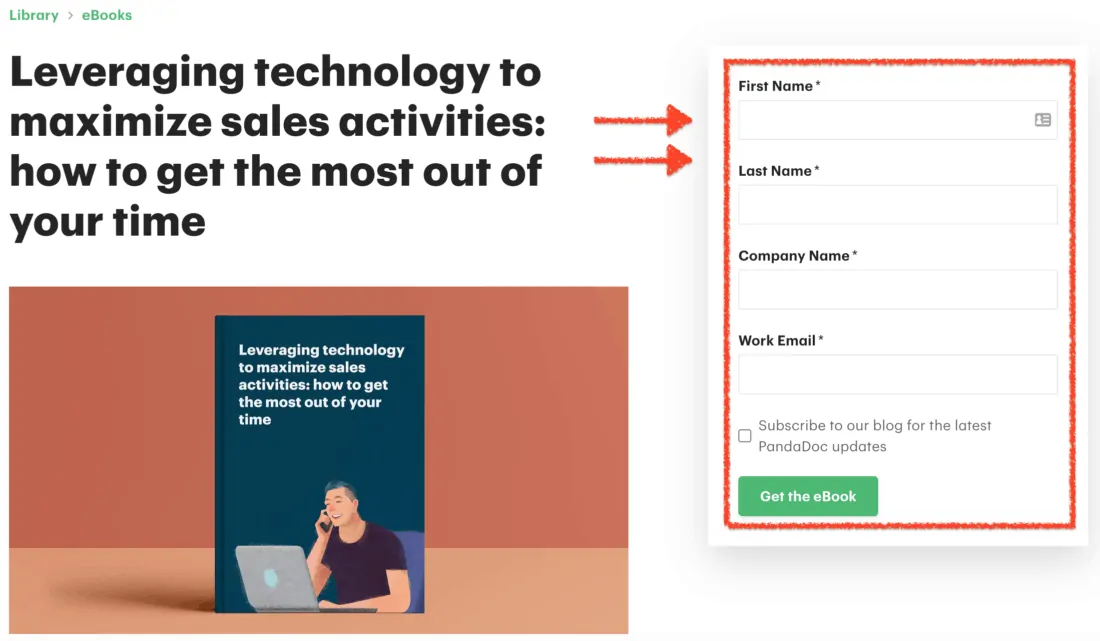
Convert Phase Tactics:
- Offering ebook(s)
- Free Quizzes
- Free 15-30 mins consultations
- Webinars
- Mini-courses
- Checklists
3.3 Close Stage (Leads to Customers)
Next in the inbound methodology is possibly the most exciting phase for any company – closing leads into customers! Finally, all that hard work turning strangers into visitors and then leads is going to pay off.
But wait…just because you turn your visitors into leads doesn’t mean those leads will necessarily become customers. There’s still some more work to be done to make that happen.
Once your visitor becomes a lead, they’ve shown interest in your company, and now it’s up to you to nurture that lead into a customer.
We do that by convincing them that the best way to solve their problem (the reason they searched and came across you in the first place) is with your product or service.
Let’s go back to that sample we love so much about purchasing CRM software. Once you filled out the form to get the eBook, you started getting emails from the software vendor. In that scenario, those emails were lead nurturing emails that served to further your relationship with the vendor in the close stage.
But remember that these emails were not merely sales emails. First, you received an email with another content offer that the vendor thought you might be interested in based on your past actions, and then, much later, you received a sales-related email.
Instead of jumping right into something sales-y, they nurtured their relationship with you by offering you valuable and educational content and then moved towards a more sales-focused communication.
How do we nurture the relationship with the lead to turn them into a customer?
By offering them valuable, educational content, some sales content to encourage the close only after the educational content.
We can use some tactics for this are emails, automated workflows, lead scoring, and a CRM system.
Close Phase Tactics:
- Marketing automation
- Automated workflows
- Lead scoring
- CRM system
3.4 Delight phase (Customers to Promoters)
Now we’ve successfully attracted strangers to our site to turn them into visitors, converted those visitors into leads, and nurtured our relationship with them to close them into customers; we’re done, right?
Wrong! Just because they’ve become a customer does not mean that your relationship with them is over!
You have an excellent opportunity to sit in front of you with people who have become customers. Your goal in the delight phase is to turn them into promoters.
Promoters are the people who talk about your company to their friends and family. They’re the people who return to continue purchasing from you and spur other purchases through their network.
Creating promoters is no easy feat. It takes lots of time, relationship nurturing, and customer service. You’re looking to over-deliver on your promises, provide value that interests your customers, and reach them at the right time.
The good news here is that many of the tactics you used in the previous stages are also valuable tactics for the delight stage though you might need to use them slightly differently.
You can continue nurturing your customers in the hopes of turning them into promoters through the use of tactics like social media, social monitoring, smart content, email, and workflows.
Delight phase Tactics:
- Loyalty / recommendation programs
- Post-sale educational content (webinars, guides)
- Social Media
#4. Conclusion
So there you have it, an introduction to inbound marketing.
Now you know why it’s important, how it works, and the ins and outs of the methodology. Inbound marketing can be precious for your company.
With the amount of information available to customers on the Internet, it’s not something you can afford to ignore.
Regardless of whether you are there or not, your prospects are searching for information about your industry online, and if you don’t take advantage of that and get in front of them, they may never come across you at all.
![You are currently viewing Inbound Marketing Guide for Managers [Complete Guide]](https://competico.com/wp-content/uploads/2020/10/Inbound-Marketing-for-Managers-Complete-Guide.webp)
